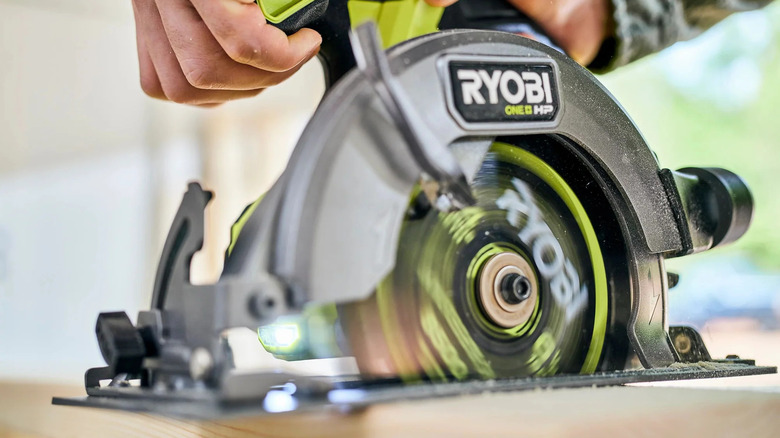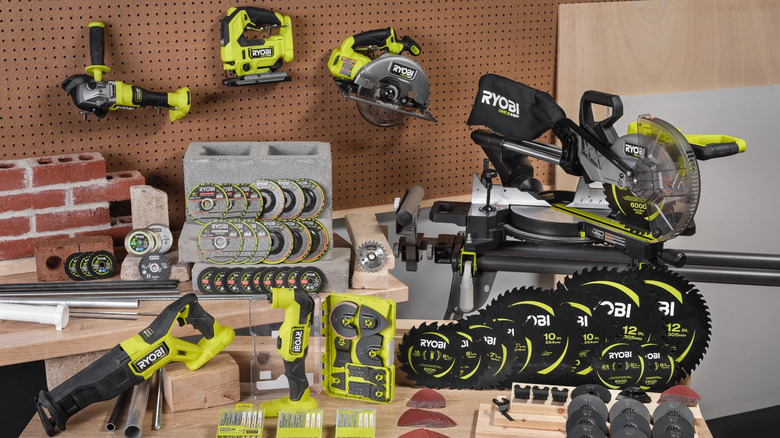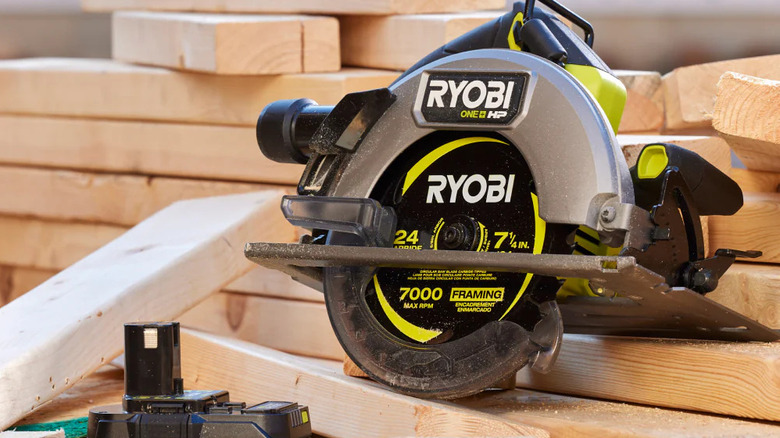Can A Ryobi Circular Saw Cut Through Metal? Here's What You Need To Know
When you think of a high-speed cutting implement like one of Ryobi's circular saws, your first inclination would probably be to use it on wood. Indeed, circular saws, much like unpowered saws, are great at cutting wood, whether it's lumber for building furniture or crafts, or large sheets like plywood. Of course, wood isn't the only material out there that could do with a good cutting, especially if you're engaged in DIY crafting and construction. One of the other major materials that needs to be cut and shaped is metal.
Arguably, the whole point of metal is that it's more resilient than wood and can't be cut or damaged as easily. Even so, with the right tool, even metal can be cut down to size. A Ryobi circular saw can be the right tool, albeit in the right circumstances and only with certain types and shapes of metal. If you try to approach a massive slab of solid iron the same way you would a chunk of lumber, you're more likely to hurt yourself or break your saw than actually cut it.
A Ryobi saw can cut metal with the right blade
Technically, a Ryobi circular saw is just a high-speed rotary mechanism. The real star of the show is the saw blade. Ryobi circular saws can have their circular blades freely swapped out, either with blades produced by Ryobi itself or third-party blade brands like Diablo. Besides being necessary for replacing blades that are worn out, this grants circular saws a higher degree of modularity. If you can't cut something with your current blade, just switch to one with a different shape or materials.
To that end, you can't cut metal with a circular saw blade designed for wood. The thin teeth on a plywood blade, for instance, would never be able to penetrate a metallic surface. A blade made of high-speed steel or carbide can handle tougher jobs like metal without chipping or breaking. Diablo in particular makes saw blades specifically for metalworking out of its proprietary mix of metal and ceramic. Some metal-cutting blades are also known as cold saw blades because the particular shape and spacing of their teeth allow them to transfer heat away from themselves, staying cool while they work. If you equip your Ryobi circular saw with one of these blades, it should be able to cut through metal.
A Ryobi saw can only cut certain types of metal
While the right saw blade will allow a Ryobi saw to cut through metal and metallic surfaces, that doesn't mean it'll be able to seamlessly saw through a giant steel girder. Even with the right blade, cutting metal can be a tall order for a circular saw. If the material is too thick, the blade may wear out before it can make any substantial headway.
A circular saw works best on mild, non-ferrous metals, such as aluminum, tin, or copper. You see these kinds of metals most frequently in things like plumbing pipe, sheet metal siding, or small bars. Thin, mild sheet metal is fairly easy for a Ryobi circular saw to cut through, more so with an appropriate metal-cutting blade. On the other hand, thicker, ferrous metals like cast iron won't even be nicked by a circular saw, no matter what kind of blade you're using. Attempting to cut cast iron with a circular saw is more likely to cause the blade to shatter, which could pose a serious risk to your safety.
A Ryobi circular saw can be a multi-purpose tool, but you should always double-check the blade you have loaded before you try to cut anything, especially metal, lest you expose yourself to danger. Whether you're a beginner D.I.Y.er or a seasoned worker, it's always important to be mindful of your safety.


